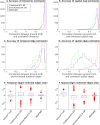The relationship between spatial configuration and functional connectivity of brain regions revisited
- PMID: 31066676
- PMCID: PMC6541435
- DOI: 10.7554/eLife.44890
The relationship between spatial configuration and functional connectivity of brain regions revisited
Abstract
Previously we showed that network-based modelling of brain connectivity interacts strongly with the shape and exact location of brain regions, such that cross-subject variations in the spatial configuration of functional brain regions are being interpreted as changes in functional connectivity (Bijsterbosch et al., 2018). Here we show that these spatial effects on connectivity estimates actually occur as a result of spatial overlap between brain networks. This is shown to systematically bias connectivity estimates obtained from group spatial ICA followed by dual regression. We introduce an extended method that addresses the bias and achieves more accurate connectivity estimates.
Keywords: dual regression; functional connectivity; functional connectomes; human; neuroscience; parcellation; resting state.
© 2019, Bijsterbosch et al.
Conflict of interest statement
JB, CB, MW, SS, SH No competing interests declared
Figures










References
-
- Bijsterbosch JD, Smith SM, Beckmann CF. In: Introduction to Resting State fMRI Functional Connectivity. Jenkinson M, Chappell M, editors. Oxford University Press; 2017.
Publication types
MeSH terms
Grants and funding
LinkOut - more resources
Full Text Sources
Miscellaneous

